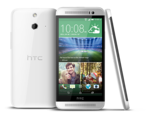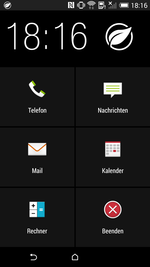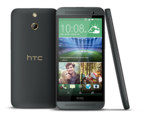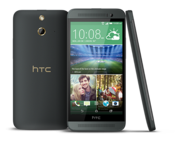HTC One E8 Smartphone Review

For the original German review, see here.
We reviewed the HTC One M8 seven months ago. It had a great metal case, good software and an innovative camera, even though the latter did not have a very high resolution with just 4 megapixels. HTC now offers a less expensive version that uses a sophisticated plastic case, a faster SoC as well as a camera with a much higher resolution. Might the One E8 even be the better smartphone? We take a closer look at the changes and come to a verdict.
We obviously use the HTC One M8 for a comparison, but also the smaller HTC One Mini 2, which is closer to the HTC One E8 in terms of the camera equipment. There are also several other devices in this price range, like the LG G2 Mini, the Huawei Ascend G750, Nokia Lumia 830 and the Alcatel One Touch Idol X+. Because of the fast SoC, other high-end devices like Apple's iPhone 6, the Samsung Galaxy S5 or the Sony Xperia Z3 are possible alternatives as well, even though their price is significantly higher.
Case
There is no size difference between the HTC One E8 and the One M8 – the dimensions are completely identical. The design with the curved back and the large speaker grilles at the top and the bottom of the screen did not change, either. The main difference is the material: The new material of choice for the case is plastic instead of metal. Even though other countries can choose between different colors for the HTC One E8, customers in Central Europe are limited to gray and white.
The plastic on the back cover feels grippy and sophisticated. It also reduces the weight of the smartphone: The HTC One E8 weighs 145 grams while the M8 weighs 160 grams. However, you will have to live with some stability drawbacks in return; the left and right sides of the back cover can be slightly pushed in and you can slightly twist the case as well, which will result in quiet creaking sounds. However, the pressure is never visible on the screen, which is once again a result of the sturdy Gorilla Glass surface at the front.
Connectivity
Software
Similar to the HTC One M8, the One E8 uses the Android 4.4 operating system. An update to Android 5.0 and the new version of HTC’s own user interface "HTC Sense" is very likely. The visual design of HTC Sense 6 differs from standard Android, but the functionality is otherwise very similar to the "Vanilla" version of Google’s operating system. HTC does not include many software additions, you get the news creator "Blink Feed" and an app that helps you to integrate your network into computing clusters for scientific and non-profit projects. The video and picture app "Zoe" does not work on the HTC One E8 (yet), which is really annoying.
Communication & GPS
There are some small changes in regard to the communication modules: The WLAN module of the HTC One E8 only supports networks with the standards 802.11 a/b/g/n, but not the very fast 802.11 ac standard. There is also support for three different UMTS frequencies; the HTC One M8 supports four. However, neither should really result in restrictions during everyday use, especially since the signal quality of the WLAN module is excellent and we cannot really criticize the reception in the mobile network, either.
The GPS module also supports the Glonass network but cannot establish a connection indoors. This process is very quick outdoors and the smartphone is located down to 7 meters.
Cameras & Multimedia
The camera at the back is another important new feature of the HTC One E8: It seems that HTC quickly waives the double lens of the HTC One M8, which enabled nice effects, but the resolution of just 4 MP and the lack of the image stabilization resulted in a lower sharpness compared to other high-end smartphones.
This time, the camera at the back has a 13 MP sensor and uses an LED flash above the sensor instead of a second lens. At the front is a 5 MP sensor, which should create decent selfies. The HTC One Mini 2 used exactly the same camera configuration.
The rear camera does not have to hide behind the rivals anymore when we look at the details: It is actually on a level with the iPhone 5 or the Nokia Lumia 1020. The pictures look sharp and the color representation is good. Similar to the HTC One Mini 2, the illumination was not always correct, the results often looked overexposed or slightly too dark. You will once again need a calm hand if you want to take a picture under bad lighting conditions since there is no image stabilizer. The front camera convinces with sharp selfies, even though we can see slightly frayed edges.
Input Devices & Handling
There are basically no changes compared to the HTC One M8 in this section: The touchscreen is still precise up into the peripheral areas and quickly executes inputs. The virtual keyboard is still identical with the HTC One M8 with all the advantages and drawbacks: Precise with many options for adjustments, but also a bit too crowded and only with an English layout.
Display
The display and the measurements are identical to the predecessor. The according information is available in our review of the One M8.
Performance
The SoC of the HTC One E8 is the Qualcomm Snapdragon 801 MSM8974AC, which is usually used for high-end smartphones like the Sony Xperia Z3. The four cores run with a clock of 2.45 GHz and are therefore slightly faster compared to the Qualcomm Snapdragon 801 MSM8974AB in the HTC One M8. Both models use the Qualcomm Adreno 330 GPU with the identical clock.
The synthetic benchmarks show that the HTC One E8 cannot surpass the One M8, despite the slightly higher-clocked SoC, but it is much faster than any other rival in this price range. It is also comparable to the Galaxy S5 or the Xperia Z3, but it cannot keep up with the iPhone 6. The differences are bigger in the GPU benchmarks, where the One E8 is usually ahead of the One M8 and all the comparison devices. The storage of the One E8 seems to be very fast and the advantage of our review unit is pretty big as a result.
The good results are a bit suspicious since the HTC One M8 used mechanisms to increase the performance in benchmarks, for example, by removing the temperature limits. However, it was easy to avoid these mechanisms; you just had to rename the corresponding benchmark. We did this with the HTC One E8 as well, but the results were identical with the renamed files. This means the smartphone is either cleverer during cheating compared to the HTC One M8 or the performance is actually a bit higher. It would be very unfortunate if HTC still believes it has to cheat to keep up with the competition.
All in all, you get high-end performance for a mainstream price, which means the One E8 is a very interesting device for performance enthusiasts with a limited budget.
| GFXBench 3.0 | |
| on screen Manhattan Onscreen OGL (sort by value) | |
| HTC One E8 | |
| HTC One M8 | |
| HTC One Mini 2 | |
| LG G2 Mini | |
| Apple iPhone 6 | |
| Samsung Galaxy S5 | |
| Sony Xperia Z3 | |
| 1920x1080 1080p Manhattan Offscreen (sort by value) | |
| HTC One E8 | |
| HTC One M8 | |
| HTC One Mini 2 | |
| LG G2 Mini | |
| Apple iPhone 6 | |
| Samsung Galaxy S5 | |
| Sony Xperia Z3 | |
| 3DMark | |
| 1280x720 offscreen Ice Storm Unlimited Score (sort by value) | |
| HTC One E8 | |
| HTC One M8 | |
| HTC One Mini 2 | |
| LG G2 Mini | |
| Huawei Ascend G750 | |
| Alcatel One Touch Idol X+ | |
| Apple iPhone 6 | |
| Samsung Galaxy S5 | |
| Sony Xperia Z3 | |
| 1280x720 offscreen Ice Storm Unlimited Graphics Score (sort by value) | |
| HTC One E8 | |
| HTC One M8 | |
| HTC One Mini 2 | |
| LG G2 Mini | |
| Huawei Ascend G750 | |
| Alcatel One Touch Idol X+ | |
| Apple iPhone 6 | |
| Samsung Galaxy S5 | |
| Sony Xperia Z3 | |
| 1280x720 offscreen Ice Storm Unlimited Physics (sort by value) | |
| HTC One E8 | |
| HTC One M8 | |
| HTC One Mini 2 | |
| LG G2 Mini | |
| Huawei Ascend G750 | |
| Alcatel One Touch Idol X+ | |
| Apple iPhone 6 | |
| Samsung Galaxy S5 | |
| Sony Xperia Z3 | |
| Sunspider - 1.0 Total Score (sort by value) | |
| HTC One E8 | |
| HTC One M8 | |
| HTC One Mini 2 | |
| LG G2 Mini | |
| Huawei Ascend G750 | |
| Nokia Lumia 830 | |
| Apple iPhone 6 | |
| Samsung Galaxy S5 | |
| Sony Xperia Z3 | |
| Octane V2 - Total Score (sort by value) | |
| HTC One E8 | |
| HTC One M8 | |
| HTC One Mini 2 | |
| LG G2 Mini | |
| Apple iPhone 6 | |
| Samsung Galaxy S5 | |
| Sony Xperia Z3 | |
| Mozilla Kraken 1.1 - Total (sort by value) | |
| HTC One E8 | |
| HTC One M8 | |
| HTC One Mini 2 | |
| LG G2 Mini | |
| Nokia Lumia 830 | |
| Apple iPhone 6 | |
| Samsung Galaxy S5 | |
| Sony Xperia Z3 | |
* ... smaller is better
Emissions
Temperature
We know that the HTC One E8 is a bit more powerful than its sibling with a metal case, but the temperature development at the case is still lower. The average temperatures under load show that the One E8 is more than 3 °C cooler at the back and 0.6 °C cooler at the front. We determined a maximum temperature of 39.2 °C at the front, which is identical to the predecessor.
There are, however, some areas of the HTC One E8 that hardly get warm at all, while the temperature distribution of the predecessor was pretty even across the whole chassis. Overall, the HTC One E8 does not get as warm as the HTC One M8. However, the warming of the latter was already pretty low in general, so the HTC One E8 is always comfortable in the hands.
(+) The maximum temperature on the upper side is 39.2 °C / 103 F, compared to the average of 35 °C / 95 F, ranging from 21.9 to 56 °C for the class Smartphone.
(+) The bottom heats up to a maximum of 37.1 °C / 99 F, compared to the average of 33.8 °C / 93 F
(+) In idle usage, the average temperature for the upper side is 28.6 °C / 83 F, compared to the device average of 32.7 °C / 91 F.
Speakers
Our verdict for the speakers is very similar to the HTC One Mini 2: The sound is not as great as it was in the case of the HTC One M8, but it is still impressive for a smartphone. The maximum volume is very high and the individual sounds are sufficiently differentiated, even with a large orchestra. The HTC One E8 cannot always avoid distortions at the maximum volume, but the front-facing stereo speakers once again create an unusually good sound for their size.
Battery Runtime
We were not really convinced by the energy management of HTC devices in the past: Compared to similarly equipped comparison devices, HTC smartphones often had shorter battery runtimes. This also applies for the HTC One E8, but there are still some positive aspects: First of all, the battery runtimes are significantly longer compared to the HTC One M8 – despite the higher performance. Our review unit is roughly on a level with the smaller HTC One Mini 2. None of the comparison devices can keep up with the performance of the HTC One E8, but some of them manage much longer battery runtimes in return. The HTC One E8 is at least equipped with the exemplary energy-saving mode that can squeeze a couple of hours from an almost empty battery.
All in all, decent results for the battery runtimes and you should be able to manage a business day with the HTC One E8, but there are devices with much longer runtimes.
| HTC One E8 Adreno 330, 801 MSM8974AC, 16 GB eMMC Flash | HTC One M8 Adreno 330, 801 MSM8974AB, 16 GB iNAND Flash | HTC One Mini 2 Adreno 305, 400 MSM8226, 16 GB iNAND Flash | LG G2 Mini Adreno 305, 400 MSM8926, 8 GB SSD | Nokia Lumia 830 Adreno 305, 400 MSM8926, 16 GB eMMC Flash | Alcatel One Touch Idol X+ Mali-450 MP4, MT6592, 16 GB eMMC Flash | |
|---|---|---|---|---|---|---|
| Battery Runtime | -21% | 1% | 96% | 24% | -19% | |
| H.264 | 543 | 385 -29% | 512 -6% | 577 6% | ||
| WiFi | 512 | 453 -12% | 546 7% | 1003 96% | 721 41% | 413 -19% |
Verdict
More performance for less money – the One E8 is definitely an interesting alternative if you like the plastic case. It inherited many good features from the One M8 as well as the smaller HTC One Mini 2, which was actually better than the One M8 in some areas. The camera of the One E8, for example, has a higher resolution and the battery lasts longer. At the same time you get more performance.
You still get the good software, the nice design and the great touchscreen. The sound quality of the speakers cannot quite keep up with the One M8, but they are very good for a smartphone nonetheless. We cannot confirm a possible cheating in benchmarks like 3DMark 2013 this time, so there is no point deduction.
The HTC One E8 is available for around 400 Euros (~$500) and can actually compete with high-end devices. There are some small drawbacks like the stability of the case or the limited communication features, but the HTC One E8 is still a real recommendation for anybody who wants a very good smartphone for a low price.


 Deutsch
Deutsch English
English Español
Español Français
Français Italiano
Italiano Nederlands
Nederlands Polski
Polski Português
Português Русский
Русский Türkçe
Türkçe Svenska
Svenska Chinese
Chinese Magyar
Magyar








